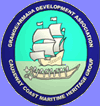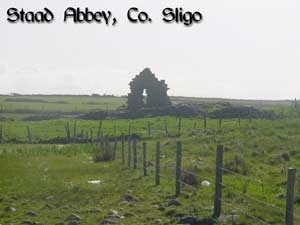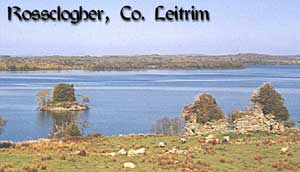| de Cuellar Trail |
| Sligo |
| Causeway Coast |
|
|
 |
The de Cúellar Armada Trail - Sligo |
|
|
Click
on the map to find out more about the areas de Cúellar's visited
on his travels.
|
|
| Streedagh
Strand (1) ( Map
| Staad | Glencar
| O'Rourke's | Lurganboy
| Largydonnell| Rossclogher
) |
|

|
|
|
A survivor, Captain Francisco de Cúellar recorded events of 413 years ago, in graphic detail. He documents his shipwreck, on Streedagh the subsequent horrors ashore, and his attempts to find hospitality from friendly chieftains (O’Rourke and McClancy) in the then English garrisoned North Sligo Leitrim, as he tried to make his way back to Spain via Antrim and Scotland. His
account paints a fascinating picture of life and living conditions
in this part of Ireland at the time. |
|
| Staad
Abbey (2)(
Map | Streedagh
| Glencar | O'Rourke's
| Lurganboy | Largydonnell
| Rossclogher ) |
|
|
 |
|
|
On returning from the beach, if the visitor walks to the top of the lane directly opposite the Spanish Armada Memorial, as you look across the intervening farmland, it is possible to discern close to the shoreline, the single surviving gable wall of Staad Abbey. To where, on gaining the shore de Cúellar walked in search of help, unfortunately the English had been there before him. “At dawn of the day I began to walk little by little, searching for a monastery of monks, that I might repair to it as best I could, which I arrived at with much trouble and toil. I found it deserted, and the church and images of the saints burned and completely ruined, and twelve Spaniards hanging in the church by act of the Lutheran English, who went abroad searching for us to make an end to us all who had escaped from the sea.” |
|
| Glencar
Waterfall(3) ( Map
| Streedagh | Staad
| O'Rourke's | Lurganboy
| Largydonnell
| Rossclogher )
At Glencar lake, de Cúellar comes upon a group of unoccupied huts, that it would appear were used for storage of oats. On entering one of these huts he finds that three other Spaniards seeking refuge already occupy it. These are his first contacts with compatriots, since leaving the beach. “and,
reaching the mountain range that they gave me for direction, I met
with a lake, around which there were about thirty huts, all forsaken
and unoccupied, and there I wished to spend the night.” |
|
|
O’Rourke’s Castle (Castletown) (4) ( Map | Streedagh | Staad | Glencar | Lurganboy | Largydonnell | Rossclogher ) Here
at Castletown, the O’Rourkes of Breffni maintained one of their
many strongholds in the district. A “dissident” chieftain, Brian
O’Rourke offered shelter and succour to the escaping Spaniards for
which amongst other “crimes” against the Crown, he suffered the
ultimate punishment, he was executed at Tyburn in London, on 3rd
November 1591. |
|
|
Lurganboy (5) ( Map | Streedagh | Staad | Glencar | O'Rourke's | Largydonnell | Rossclogher ) De Cúellar was part of a party of twenty Spaniards that went in search of a ship, word of which they had received while staying with O’Rourke. Separated from his compatriots because of injuries sustained in the wrecking, lost and disoriented , he stumbles along in what he hopes is the general direction he should be going. “Going
along thus, lost with much uncertainty and toil, I met by chance
with a road along which a clergyman in secular clothing was traveling.
He was sorry for me, and spoke to me in Latin, asking me to what
nation I belonged and about the shipwrecks that had taken place.
God gave me grace that I was able to reply to everything that he
asked me in the same Latin tongue; and so satisfied was he with
me, that he gave me to eat of that which he carried with him, and
he directed me by the right road that I should go to reach a castle,
which was six leagues from there.” |
|
|
Largydonnell (6) ( Map | Streedagh | Staad | Glencar | O'Rourke's | Lurganboy | Rossclogher ) Here in the lonely Glenade Valley, while following the directions given him by the Clergyman, Francisco now falls in with another traveler, who tricks him into going to his forge in the valley where it is his intent to hold de Cúellar captive and force him to work for him. “I
set out there experiencing much trouble on the road, and the greatest,
and that which gave me most pain, was that a savage that met me
on the way, and by deceiving me, took me to his hut in a deserted
valley, where he said I must live all my life, and he would teach
me his trade, that of blacksmith.” |
|
| Rossclogher
Castle (7) ( Map
| Streedagh | Staad
| Glencar | O'Rourke's
| Lurganboy | Largydonnell
) |
|

|
|
|
Here at Rossclogher just outside Kinlough on the southern shore of Lough Melvin de Cúellar came under the protection of McClancy with whom he stayed for three months. Maglana, as de Cúellar referred to McClancy, paid like O’Rourke with his life, shot and then beheaded, at Lough Melvin, in 1589. “The
wife of my master was very beautiful in the extreme, and showed
me much kindness. One day we were sitting in the sun with some of
her female friends and relatives, and they asked me about Spanish
matters and of other parts, and in the end it came to be suggested
that I examine their hands and tell them their fortunes. Giving
thanks to God that it had not gone even worse with me than to be
a gypsy among savages, I began to look at the hands of each, and
to say to them a hundred thousand absurdities, which pleased them
so much that there was no other Spaniard better than I, or than
was in greater favour with them.” |
|

